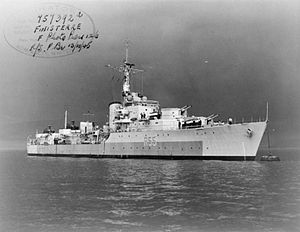HMS Hogue was a Battle-class destroyer of the Royal Navy that was commissioned during the Second World War. She was named after the Battle of La Hogue, fought between the British and French in 1692; the ship's badge a chess rook on a field blue, within a chaplet of laurel gold was derived from the arms of Admiral Sir George Rooke who distinguished himself at the battle.
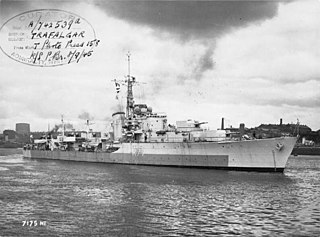
HMS Trafalgar was a Battle-class destroyer of the Royal Navy (RN). She was named after the Battle of Trafalgar, a decisive British victory over a Franco-Spanish Fleet in 1805. Trafalgar was built by Swan Hunter on the Tyne. She was launched on 12 January 1944 and commissioned on 23 July 1945.

HMS Camperdown was a Battle-class destroyer of the Royal Navy (RN). She was named after the Battle of Camperdown, a naval engagement between the British and Dutch that took place in 1797, and which resulted in a British victory.
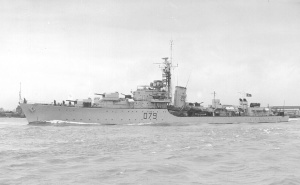
HMS Cadiz was a Battle-class destroyer of the Royal Navy. She was named after the Battle of Cádiz, in which the French besieged the Spanish town in 1810, which was eventually lifted in 1812 after the French defeat at the Battle of Salamanca.

HMS Barrosa (D68) was a later or 1943 Battle-class fleet destroyer of the Royal Navy.
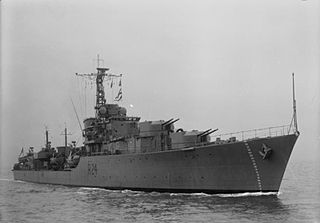
HMS Gravelines was a Battle-class destroyer of the Royal Navy. She was named after the Battle of Gravelines, which took place in 1588, resulting in the English Navy defeating the Spanish Armada. Gravelines was built by Cammell Laird of Birkenhead. She was laid down on 10 August 1943, launched on 30 November 1944 and completed on 14 June 1946.

HMS Corunna (D97) was a later or 1943 Battle-class fleet destroyer of the Royal Navy. She was named in honour of the Battle of Corunna, which took place during the Peninsular War in 1809 between British and French forces. Corunna was built by Swan Hunter & Wigham Richardson Limited on the Tyne. She was launched on 29 May 1945 and commissioned on 6 June 1947.
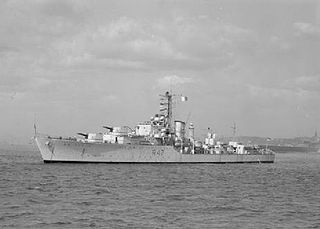
HMS Gabbard was a Battle-class destroyer of the Royal Navy (RN). She was named in honour of the Battle of the Gabbard, which occurred in 1653, and which resulted in an English victory over the Dutch Fleet. Gabbard was built by Swan Hunter & Wigham Richardson Limited on the Tyne. She was laid down on 2 February 1944, launched on 16 March 1945 and completed on 10 December 1946.

HMS Solebay was a Battle-class destroyer of the Royal Navy (RN). She was named after the Battle of Solebay which took place in 1672 between an Anglo-French force and the Dutch Navy during the Third Anglo-Dutch War. Solebay was built by R. & W. Hawthorn, Leslie & Company Limited on the Tyne. She was launched on 22 February 1944 and commissioned on 25 September 1945.

BAPFerré(DM-74) was a Daring-class destroyer in service with the Peruvian Navy from 1973 to 2007. She was built by Yarrow Shipbuilders and completed for the Royal Navy in 1953 as HMS Decoy (D106).

HMS Dainty was a Daring-class destroyer of the British Royal Navy. Ordered in 1945, she was built by J. Samuel White at their Isle of Wight shipyard, being launched in 1950 and completed in 1953.
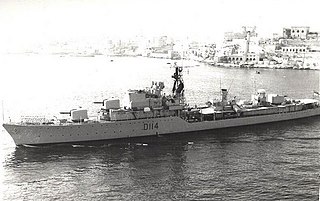
HMS Defender was a Daring-class destroyer of the Royal Navy.

HMS Scorpion was a Weapon-class destroyer of the British Royal Navy in service from 1947 and scrapped in 1971. Originally named Centaur, the ship was renamed Tomahawk and finally Scorpion before her launch.
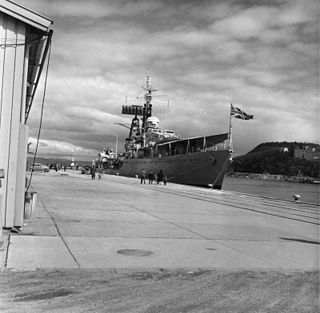
HMS Crossbow was a Weapon-class destroyer of the Royal Navy that was in service from 1948 and scrapped in 1972.

HMS Rocket was an R-class destroyer of the Royal Navy that saw service during Second World War. Built by Scotts Shipbuilding and Engineering Company in Greenock, Scotland, she was launched in October 1942 and commissioned in August 1943.
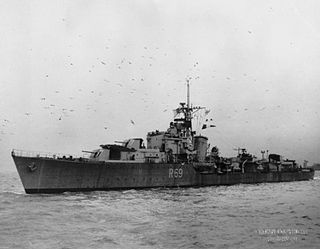
HMS Ulysses was a U-class destroyer of the British Royal Navy that saw service during World War II. She was later converted into a Type 15 fast anti-submarine frigate, with the new pennant number F17.

HMS Myngs was a Z-class destroyer of the Royal Navy built as a flotilla leader by Vickers-Armstrongs, High Walker. She served in the Second World War, taking part in operations in the North Sea and off the Norwegian coast, before taking part in some of the Arctic convoys. She spent a further ten years in Royal Navy service after the end of the war, before being sold to the Egyptian Navy, which operated her as El Qaher. She was sunk in an Israeli air attack on 16 May 1970.

HMS Crispin was a C-class destroyer of the Royal Navy built by J. Samuel White, Cowes between 1944 and 1946. She was originally to have been named HMS Craccher. She was sold to the Pakistan Navy in 1958 and renamed PNS Jahangir. She was scrapped in 1982.
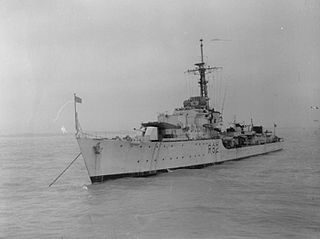
HMS Creole was a C-class destroyer of the Royal Navy built by J. Samuel White, Cowes between 1944 and 1946. She was sold to the Pakistan Navy in 1958 and renamed PNS Alamgir. She was scrapped in 1982.

HMS Contest was a C-class destroyer of the Royal Navy, built by J. Samuel White, Cowes. Laid down on 1 November 1943 and commissioned on 9 November 1945, she was the Royal Navy's first all-welded warship. She was scrapped in 1960.
